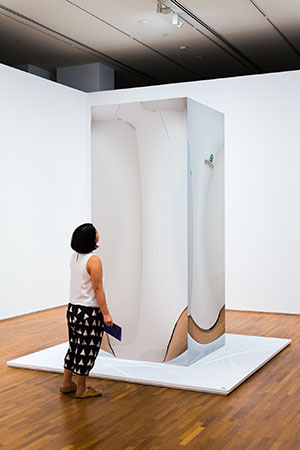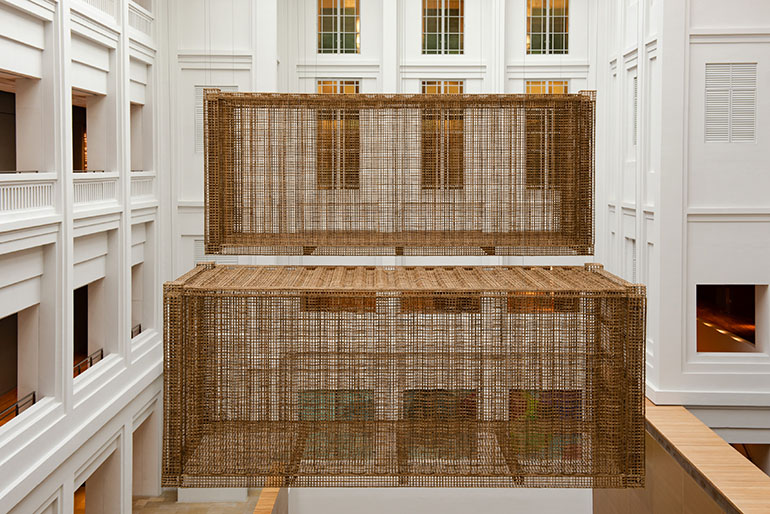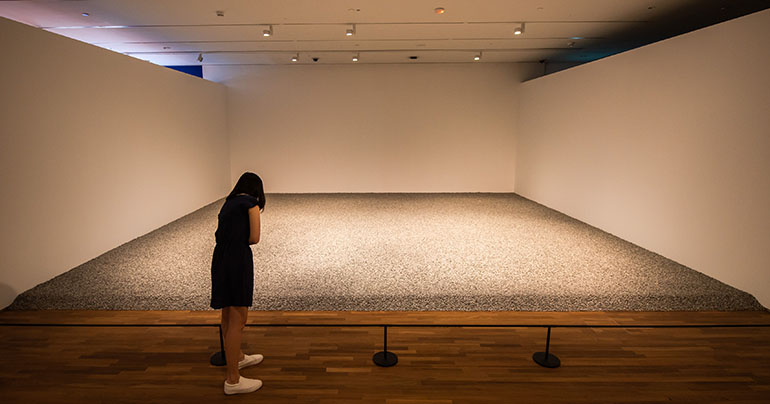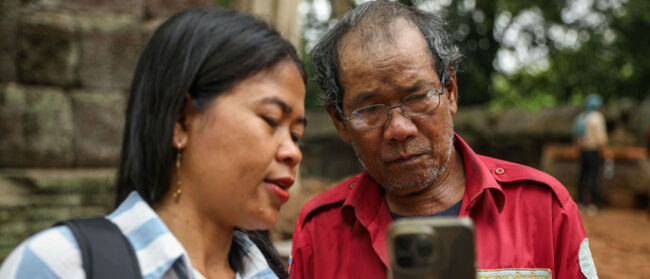Pich Sopheap’s newest installation hangs from the glass roof of National Gallery Singapore, two imposing structures the size and shape of shipping containers cutting across several stories of the open foyer. There is a weightless quality to them; instead of the opaque steel of the docks, Sopheap, who is widely considered one of Cambodia’s leading international artists, has woven together rattan and bamboo to encase a sculpture of pure air, transforming a capitalist symbol of global trade into something that truly transcends borders.
“[The shipping container] transports objects, it transports ideas and culture,” Sopheap told Southeast Asia Globe. “The world becomes closer together – let’s say global.”
Combining traditional Cambodian weaving techniques and industrial imagery to create an experience both visual and visceral, Cargo was commissioned for the gallery’s latest exhibition, Minimalism: Space. Light. Object., an exploration of the history and influences of the minimalist art movement from its origins in abstract expressionism to today’s more immersive installations. Crucially, though, the exhibition – the first of its kind in Southeast Asia – places minimalism in a distinctly Asian context, arguing that what has traditionally been viewed as a movement rooted in the West in the 1950s and 60s in fact draws largely from far older spiritual traditions in East Asia.
“Minimalism was also happening in Japan way before the word was created,” Sopheap said. “For me, making these two containers was kind of a response to that notion that things and ideas are not just from one place but in fact travel from culture to culture, from country to country.”

Minimalism takes the art object at its face value, prioritising the audience’s experience of that object in space rather than attaching particular importance to it. Sopheap described the key to understanding the movement as stripping back layers of meaning – to appreciate the object purely for what it is.
“That, to me, is what a lot of the time people miss – when people ask me, ‘What does it mean?’ before they look at the sculpture,” he said. “Well, first look at it. It’s about the experience of looking at something, and when you’re done with it, then you can start thinking about explaining what it means. That’s what minimalist objects demand of you – you need to look, and you need to see.”

Characterised by the repetition of the simplest geometric forms, minimalism and its focus on immateriality, emptiness and awareness is rooted in Zen Buddhist practices that travelled from mainland China to Japan in the 8th century. More than 1,000 years later this philosophy, which recognises the emptiness of inherent existence as a pathway to liberation, set fire to the imaginations of a number of New York artists caught in the shifting chaos of the 20th century.
This is the path traced by the Singapore exhibition, which takes visitors through the original American stalwarts of minimalism such as Donald Judd and Mark Rothko before moving to more contemporary names such as the British Martin Creed and Anish Kapoor. Kapoor’s curved sculpture Void (1993), a cavernous felt sculpture suspended in air, plays with the viewer’s perception of depth, its dark blue pigment giving the impression of an infinite concave space within a finite structure.
The exhibition places these Western figures alongside Asian counterparts who draw more explicitly upon their own minimalist traditions – most notably the provocative Chinese dissident Ai Wei Wei and Japanese artist Tatsuo Miyajima. Miyajima’s work Mega Death (1996/2016) responds to the war and violence of the 20th century through an enormous LED display that enfolds the viewer and soaks the room with a blinding blue light, endless columns of numbers repeatedly counting down from nine but never reaching zero. As each changing number is extinguished, the cycle starts again and zero itself becomes a void, a point never reached.
“It’s the meaning of life,” Miyajima said. “Life and death, it’s circular, it’s reincarnation. This is a Buddhist concept. It means infinite life.”
For Southeast Asian artists from countries with less of a contemporary history of painting and sculpture, such as Cambodia and Myanmar, minimalism has become a way to break free from the constraints of traditional styles. Conceptual artist Po Po uses a mixture of painting, photography, installation and performance to challenge the stifling aesthetic mores of his homeland Myanmar.
Working under the violent military junta that isolated the country from the world for decades, Po Po and other Burmese artists were bound by strict censorship laws and prevented from producing anything more provocative than Socialist realist styles of art or classical religious renderings of Buddha.
“The truth is I got tired of both of them, simply,” Po Po told Southeast Asia Globe. “We were brainwashed daily, from morning until bedtime, through radio and newspapers [that used] those two propaganda art styles. I believe that art means creating something new or different from the existing works before me.”
Po Po’s simple, geometric shapes and distinctly erotic silk sculptures proved abstract enough to be able to evade censorship boards, and he eventually cemented his place at the forefront of artistic experimentation in Myanmar after becoming one of the first artists to display work outside of the country as the nation began to open up in the 1990s.

On display in Singapore is one of his earlier works, Red Cube, which illustrates this minimalist aesthetic and the experimental thought process that birthed it. The piece shows two adjoining canvas squares painted with shades of red and black, giving the appearance of depth, hung diagonally so that a corner points at a pile of metamorphic rock on the floor.
“Red Cube is the result of an attempt to be free from the limitation of art,” he said. “In other words, it is an answer for questions such as ‘Why are paintings always rectangular in shape?’, ‘Why are they displayed on the wall horizontally?’ and ‘Why aren’t there any 3D paintings?’… I had no idea of minimalism when I was creating [my work].”
Both Sopheap and Po Po believe that the nascent contemporary art scenes in both Cambodia and Myanmar still put too much emphasis on traditional forms and themes.
“Most artists – of painting and sculpture – still enjoy copying nature in their works,” Po Po said. Despite the lifting of censorship restrictions, he added, artists continued to restrict their palette to satisfy Myanmar’s smaller art market and the widespread demand from galleries and collectors for more conventional pieces. But for Po Po, the minimalist ideal endures in everything from the sleek smart phones that have swept Southeast Asia to the clean lines of modern houses.
“Every form of art has something or some kind of unique point which is different from the rest,” he said. “This depends on the artists’ choice to put them into use. A work of art can be appreciated by everyone, young and old, and it is the same with minimal art. A work of minimalism can display its existence in the loudest, clearest and the most distinct way. But one needs to leave out all the familiar things in art – dramatic themes, subject matters – to experience it.”


